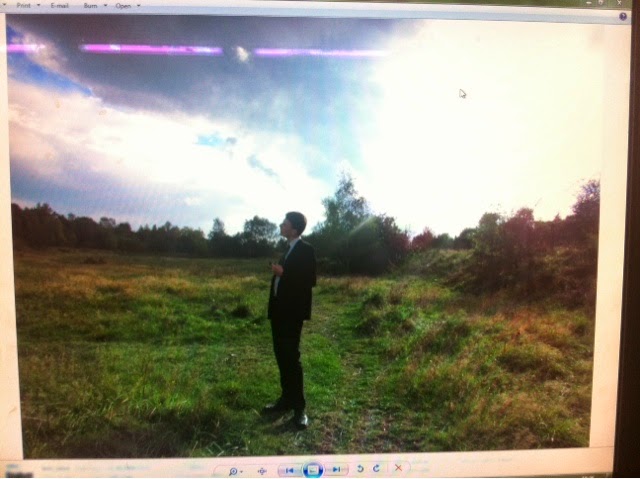The title sequence starts with pulsing music that is played over the Universal Pictures logo; the use of this music immediately gives the audience the impression of a foreboding and unsettling atmosphere. This music continues as the beginning credits start to play until there is a crackling sound, like one you'd hear on a TV or radio, and the title starts to appear, firstly blurry and out of focus but it soon sharpens up. There is a loud static noise behind the titles which connotes a lack of clarity or possibly a hidden message. This causes the audience to ask themselves questions, thus increasing the tension by playing on the fear of the unknown.
We then hear a tinkling piece of music and the words 'Civic TV' appear several times in different colours on the screen, before an advert for it comes up afterwords and we see that we are watching this on a TV screen. The fact that the Civic TV logo comes up immediately after the title suggests that it is of significance and will be important to the film's plot later on or is a key theme throughout.
We then see a young woman appear on the screen and she starts talking to a man called Max; she begins to engage in a dialogue with him and at first the audience is unsure of whether or not this is a programme but as the title sequence progresses, it becomes clear that it is directly aimed at the owner of the TV set it is playing on. She later reveals herself to be Friday James and she emphasises that she is Max's daily wake up call for Wednesday 23rd. The emphasis she puts on the date is an effective use of narrative enigma as it makes the audience question the significance of this date, creating a sense of the foreboding unknown.
She then starts reading out a message with a list of things Max has to do; this makes the audience assume that he is a character of significance in the reality he's living in as normal people don't usually have several meetings per day. Furthermore she refers to him as 'commander', suggesting he is the boss or the leader of whatever company she works for or with. This creates a sense of authority for this Max character before he even appears on screen.
The Civic TV logo plays once more, reinforcing the significance of it to the audience, before the camera pans around to a man waking up on a sofa; we can assume that this is Max.
We then see him making himself a cup of coffee whilst eating out of a box of leftover pizza; this juxtaposes our ideas of characters with authority and power as we'd expect them to be eating full meals or being made meals by cooks, not eating leftovers. The fact that he doesn't make himself any new breakfast almost makes him appear slightly sleazy and a slob; this sleaziness is further emphasised as he picks up pictures of naked women and starts flicking through them. This establishes another difference between the character of Max and a normal middle-aged man, as we would expect a normal man to read the paper on the morning (maybe in this day and age, go on his iPhone) whereas Max is flicking through pornographic images. This creates a distinct impression that he is not like your 'run of the mill' guy and reinforces his authority and power. As he is viewing the pictures, he laughs which suggests that he has a poor attitude towards woman and finds it fun to exploit and mock them for his own amusement. This establishes that there is a power struggle between men and women that may become more significant later.
I think this film would be aimed at an audience in the 28-50 age range as it already hints at some more sophisticated ideas that would be too advanced for many in the younger age ranges. It also immediately shows adult images so it definitely wouldn't be suitable for children.






























